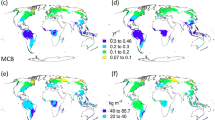Abstract
General circulation models indicate substantial CO2 warming in high latitudes. In these regions, which include the boreal coniferous forests, the activity of ecosystems is largely controlled by temperature. The effective temperature sum (degree-days) is used in this study for describing the regional variability in the productivity of boreal ecosystems. Although the concept is simple, it takes into account two basic factors: the length of the growing season and the day-to-day level of activity of the ecosystem. This study examines which areas in the boreal coniferous forests would be most sensitive to a possible climatic warming. The data used in the study are for Finland.
A regression is estimated between regional forest growth rate and effective temperature sum. A climatic warming is assumed and the corresponding growth response is calculated, using the regression, for northern and southern areas, and for maritime and continental areas. The response is expressed in terms of (i) absolute increase in growth (grams per m2 per year) and (ii) relative increase in growth. The results indicate that a given climatic warming would yield the greatest absolute increase in growth in warm (i.e. southern) and maritime parts of the biome. In terms of the relative growth response the sensitivity would increase northward and toward maritime areas.
Similar content being viewed by others
References
Arnold, C.Y.: 1959, ‘The Determination and the Significance of the Base Temperature ir a Linear Heat Unit System’, Proc. Am. Soc. Hort. Sci. 74, 430–445.
Arovaara, H., Hari, P., and Kuusela, K.: 1984, ‘Possible Effect of Changes in Atmospherii Composition and Acid Rain on Tree Growth: An Analysis Based on the Results of Finish National Forest Inventories’, Commun. Inst. For. Fenn. 122.
The Global 2000 Report to the President: 1980, Vol. 2, U.S. Council on Environmental Quality.
Hämet-Ahti, L.: 1981. ‘The Boreal Zone and its Subdivision’, Fennia 159, 69–75.
Heino, R. and Hellsten, E.: 1983, ‘Climatological Statistics in Finland’, Meteorological Yearbook of Finland, Vol. 80, Part 1a.
Kolkki, O.: 1969, ‘Overview of the Climate in Finland’, Report No. 18, Finnish Meteorologi- cal Institute (in Finnish).
Manabe, S. and Stouffer, R.J.: 1980, ‘Sensitivity of a Global Climate Model to an Increase of CO2 Concentration in the Atmosphere’, J. Geophys. Res. 85, 5529–5554.
Mikola, P.: 1950, ‘On Variations in Tree Growth and their Significance to Growth Studies’, Commun. Inst. For. Fenn. 38, 5.
Mukula, J., Rantanen, O., and Lallukka, U.: 1978, ‘Crop Certainty of Oats in Finland 1950–1976’, Report No. 10, Agricultural Research Centre, Department of Plant Husbandry, Jokioinen (in Finnish).
Sarvas, R.: 1972, ‘Investigations on the Annual Cycle of Development of Forest Trees. Active Period’, Commun. Inst. For. Fenn. 76, 3.
Yearbook of Forest Statistics: 1983, Official Statistics of Finland, Vol. XVIIA, No. 14; Folia Forestalia 550.
Author information
Authors and Affiliations
Rights and permissions
About this article
Cite this article
Kauppi, P., Posch, M. Sensitivity of boreal forests to possible climatic warming. Climatic Change 7, 45–54 (1985). https://doi.org/10.1007/BF00139440
Issue Date:
DOI: https://doi.org/10.1007/BF00139440




